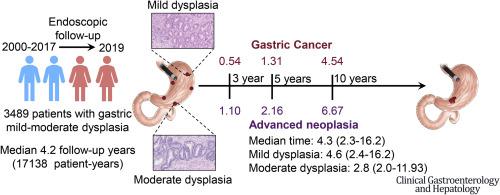Clinical Gastroenterology and Hepatology ( IF 12.6 ) Pub Date : 2021-10-28 , DOI: 10.1016/j.cgh.2021.10.032 Shiyu Xiao 1 , Haoping Lu 1 , Yan Xue 1 , Rongli Cui 1 , Lingmei Meng 1 , Zhu Jin 1 , Zhihao Yin 1 , Liya Zhou 1

|
Background & Aims
The natural course of gastric mild-moderate dysplasia in a country with high incidence of gastric cancer (GC) is relatively unknown. We aimed to determine the long-term cumulative incidence of and risk factors for advanced neoplasia in patients with gastric dysplasia.
Methods
This was a single-center observational study including all consecutive patients diagnosed with gastric mild-moderate dysplasia between 2000 and 2017. Follow-up data were collected until December 2019. We determined the cumulative incidence of advanced neoplasia and identified risk factors with Cox regression.
Results
A total of 3489 consecutive participants were followed for a median of 4.19 years from initial mild-moderate dysplasia diagnosis. The median surveillance interval between index endoscopy and next follow-up endoscopy was 1.08 years, and more than half of patients had at least 3 surveillance gastroscopies. During the study period, the majority of participants did not show disease progression, either with dysplasia not detected (51.4%) or with persistent dysplasia (46.1%). There were 88 (2.9%) patients (5.13 per 1000 patient-years) who progressed to advanced neoplasia within a median of 4.3 years. The annual incidence of advanced neoplasia and GC were 0.43% and 0.26%, respectively, within 5 years of mild-moderate dysplasia diagnosis. Increasing age, male sex, moderate dysplasia, dysplasia detected in fundus or cardia at index endoscopy, and persistent Helicobacter pylori infection during follow-up were independent risk factors for developing advanced neoplasia.
Conclusions
Even in a country with high incidence of GC, the majority of patients with gastric mild-moderate dysplasia did not experience disease progression in the long term. Intensified surveillance during the first 5 years after mild-moderate dysplasia detection is suggested.
中文翻译:

胃轻中度发育不良的长期结果:真实世界的临床经验
背景与目标
在一个胃癌 (GC) 高发国家,胃轻中度发育不良的自然病程相对未知。我们旨在确定胃发育不良患者晚期肿瘤的长期累积发病率和危险因素。
方法
这是一项单中心观察性研究,包括 2000 年至 2017 年期间诊断为胃轻中度发育不良的所有连续患者。随访数据收集至 2019 年 12 月。我们确定了晚期肿瘤的累积发病率,并通过 Cox 回归确定了危险因素。
结果
从最初的轻度中度发育不良诊断开始,总共对 3489 名连续参与者进行了中位 4.19 年的随访。首次内镜检查与下一次内镜检查的中位监测间隔为 1.08 年,超过一半的患者至少进行了 3 次监测胃镜检查。在研究期间,大多数参与者没有表现出疾病进展,要么未检测到发育异常(51.4%),要么存在持续性发育异常(46.1%)。有 88 名 (2.9%) 患者(每 1000 患者年 5.13 名)在中位 4.3 年内进展为晚期肿瘤。在轻中度不典型增生诊断后的 5 年内,晚期肿瘤和 GC 的年发病率分别为 0.43% 和 0.26%。年龄增长、男性、中度发育不良、指数内镜检查发现眼底或贲门发育不良,随访期间幽门螺杆菌感染是发展为晚期肿瘤的独立危险因素。
结论
即使在 GC 高发的国家,大多数胃轻中度发育不良的患者在长期内也没有出现疾病进展。建议在轻中度发育异常检测后的前 5 年内加强监测。


























 京公网安备 11010802027423号
京公网安备 11010802027423号